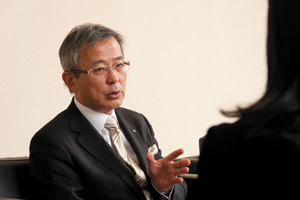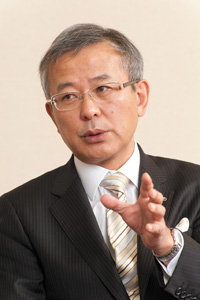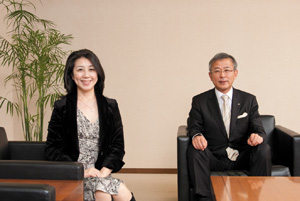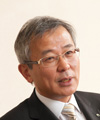Facing change with the right attitude
based on four keywords
––Mr. Shinohara, you have been involved in research and development (R&D) management and planning for quite some time. Looking back at the path taken to date, how do you think the NTT Group should posture itself going forward?
In the past, most R&D at NTT was undertaken by creating five- and ten-year visions as in a planned economy and working accordingly to meet the objectives set therein. Today, however, it goes without saying that world trends are changing at an increasingly rapid pace.
In contrast to the previous era in which new technologies brought great change to society, today it is customer needs that are becoming a major factor driving the world we live in. At the same time, intense competition and other factors in the external environment are having a big impact on the market.
Under these conditions, I don’t think we will be able to survive unless we combine three different approaches. The first is pursuing R&D with a long-term vision, the second is pursuing R&D that anticipates customer needs and creates new trends, and the third is cultivating a development mindset that allows us to quickly identify and respond to new social trends over the short term. This calls for a new management style.
I can describe my management policy as “sustainable, open, agile, and global.” I would like to explain the meaning of these four keywords.

Technology development that blossoms
over many years of effort—adopting a
sustainable approach to research
As the word implies, “sustainable” means the ability to continue on. This is a keyword directed toward our researchers. It’s easy to terminate a certain line of research but nearly impossible to resume it. When research is being done on a certain topic, it may happen that a totally unexpected discovery comes along that puts that research on a path different from the original objective. In any case, research must be continued in order to bear fruit.
For example, R&D of optical fiber technology began about two years before I entered NTT and has continued ever since to produce the amazing results that we see today. The concept of “scrap and build” may sound appealing, but when it comes to research and development, being resolute in purpose is a must. So to all our fine researchers, I say, “Let’s pursue research and development in a sustainable manner.”
Adopting an open attitude:
“raising our hand” to reveal ourselves
At present, the areas covered by information communications are extensive—much more so than in the telephone era—and the supporting technologies are broad as well. It should be obvious that it is becoming impossible for us to cover all of these areas by ourselves especially if we are to face the changes around us with a sense of urgency. Researchers, however, are apt to want to research a certain topic all the way from start to finish; they crave that feeling of individual accomplishment. This is why I am firmly committed to a theme of open innovation and collaboration and am accelerating its adoption. And here, I’m not just talking about tie-ups with outside companies. I believe it’s important that we work with parties within the NTT Group and the NTT R&D Laboratories Group, too. Furthermore, I don’t mean collaboration just in the complementary sense in which we ask others to provide the technological expertise we don’t possess. It is also important that we search out cooperative methods in which we can make “1+1 = 3” by synergistically joining forces.
Let me give an example of how collaboration within NTT R&D produced an effective result.
There was a need at one time to install optical fiber into older condominium buildings, but the existing conduits had little extra space to accept new wiring. The group researching and developing optical fiber and the group researching cable materials consequently joined forces in a joint project to tackle this problem. In the end, they succeeded in developing thin and low-friction indoor optical cables that could be smoothly slipped into tight places, thereby resolving the problem. This was the first cable of this type in the world, and try as they might, other companies around the world could not duplicate it. I think it’s fair to say that such a result could be achieved precisely because research and development at NTT R&D is so broad-based.
I can also give an example of how collaboration between NTT R&D and a party outside NTT is producing good results. I’m referring specifically to Jubatus, which is a distributed processing framework for deep analysis of big data in real time, which we jointly developed with some young developers of a Japanese venture company. Up until now, our development style had been for the most part to place orders with manufacturers for products that we decided to develop based on our technology. Now, however, we are changing this style and adopting an approach in which we try to produce something in a joint manner.
In addition, our R&D efforts are producing results that can be used and applied for purposes other than communications. One example is Revtrina, a reverberation control system that received a Japan Audio Society prize in December 2012. It was originally developed as a technology for improving the sound quality of phone calls, but we encountered opportunities to provide this technology to companies in fields outside of communications for adoption in audio equipment and other devices. Incidentally, as a technology that can control reverberation without having to reprocess the original sound, it has been highly praised by music distribution companies that own the publication rights to the music of rock bands such as Queen and the Rolling Stones, and it has even been adopted by movie theaters for use in screening movies. In short, Revtrina has gained a good reputation among professionals in various fields.
Moreover, as announced in a recent press release, we have successfully fabricated a conductive composite material that is mild on the skin by coating fiber with a conductive polymer. This product demonstrates the potential to continuously monitor a person’s heartbeat and to perform electrocardiogram tests via a piece of clothing the person is wearing, and it holds the promise of tie-ups with companies in the medical field and other industries. Looking forward, I would like to see more of our R&D results be put to such positive use.
Although the NTT name is and has always been known for communications, a diverse array of byproducts has been coming out of the R&D process for communications. For example, the laser was developed for use in communications, but it has also come to be particularly useful in identifying the district where rice was produced. This is done by lasing a grain of rice to determine its water content. While I don’t think such applications will make a name for NTT as strongly as communications has, I think it is important that we have many technologies that can make a viable contribution to society by simply looking at them in a slightly different way. I also believe that we should use our technologies to develop business in new fields to provide the firm with new sources of revenue in addition to those from voice-related operations. In short, we should apply and develop the technological assets that we as a company possess.
In this way, I think it will become possible for us to contribute to new fields and create value by collaborating with other industries with which we have had no points of contact in the past. To this end, I would like to see us take on a mindset such that when determining whether the technologies that we are researching and developing can be put to good use, we consider not just our own ideas but also the ideas of other companies and groups that wish to collaborate. Likewise, I would like to see us become accustomed to creating opportunities for others to get to know our technologies.
We also need to reflect on a few things in relation to NTT’s customary approach of taking the initiative in searching out a partner for collaboration purposes. To begin with, ideas in this regard have so far only reflected the viewpoint of NTT. This creates a narrow perspective with the result that a hunt for a partner takes more time. However, making this a bidirectional process can shorten the time involved as well as broaden our perspective. In addition, each prospective partner has its own practices, dynamics, and needs. Analyzing such characteristics takes time in itself. If, on the other hand, we make an effort to reveal ourselves and “raise our hand” to attract attention to the technologies that we possess, it should be possible to promptly get the partner we need to perform the selection process for us and become a valued partner.

Responding to customer needs with a sense of
urgency: agile, on-sight development
Our past approach to research and development was to provide NTT’s business companies with sound, complete products, or, to put it another way, products “scoring a full 100 points.” However, considering that even “80-point” products should be acceptable to customers, I think we should make a change to a “beta version” approach in which we provide such products as promptly as possible to meet customer needs. Then, once these products are in the customers’ hands, we can make on-site visits to the business companies and refine these products as needed while listening to what customers have to say.
NTT DOCOMO’s voice-activated concierge service called “Shabette Concier” is one example of this approach. The original technology used here for answering user questions on a mobile phone was developed by NTT DOCOMO itself. The service evolved, however, when NTT researchers visited NTT DOCOMO and worked with their staff to further research and develop the technology. This collaborative process resulted in the introduction of Japanese-language processing and a more enjoyable conversational experience.
We have begun to apply our technologies to other fields as well. For example, with the aim of improving customer satisfaction and creating even better services, we have brought voice-recognition, emotion-estimation, and other technologies from NTT R&D to NTT contact centers where comments and claims are received so that customer input can be analyzed in a more accurate manner.
––Has this 80-point concept been well received?
First of all, establishing specific criteria for achieving “80 points” in a product is difficult. Although we may know when a certain product has a “passing” grade, we may be totally in the dark as to what customer needs must be satisfied to achieve a 100-point, complete product. I think that the portion of product development that must be performed to reach a perfect score requires a great deal of effort since it requires that we first determine what it is that customers really need and then accurately reflect their demands in the product. It’s exactly because we live in an era of diverse customer needs that deciding on what makes a 100-point product is so difficult. This is why it is necessary to complete a product at sites close to the market.
Becoming a global leader in new
world markets and fields
NTT R&D has expanded its activities to include standardization and tie-ups with overseas universities as well as the global provision of R&D results.
Last year, we succeeded in selling more than 10 billion yen worth of optical devices and encryption technology for delivering video of the Olympic Games, the World Cup, and other events. Furthermore, in addition to tie-ups with venture companies and cooperative activities with the open source community, we are also expanding our proposals for new open source software on a global basis.
At the same time, the international expansion of NTT business is accelerating rapidly. In this regard, I would like to actively provide technologies that we have researched and developed to overseas group companies that have been increasing in number through merger and acquisition activities. I also think that we need to create an environment conducive to creating new products as a global business strategy. In the United States, open innovation thrives, markets are active, regulations are relatively easy to satisfy, and venture companies are abundant. I want R&D to support NTT’s global strategy announced in last year’s Medium-Term Management Strategy by setting up a new R&D base in North America that is blessed with this open environment, and using this base as a means of providing the services that are researched and developed in North America throughout the world.
––Please tell us more about this R&D base in North America and other activities tied to NTT’s Medium-Term Management Strategy.
Preparations are now in place to open this North America R&D base in April 2013. The plan is to locate the base on the west coast and to begin with the R&D of security- and cloud-related technologies and services. I would like to start off with 30–40 employees and expand the staff gradually over time. We plan to build a vigorous team composed of both locally hired personnel and staff members drawn from group companies, and with this team, we intend to promote open innovation without delay from North America while listening closely to market demands. The current name planned for this R&D base is NTT Innovation Institute, Inc. (provisional), or NTT I3 for short. As opposed to creating a perfect organization for this base from the very start, we intend to make adjustments as needed as the institute grows.
Furthermore, with an eye to the next stage of R&D, we will need to achieve a simple, friendly, and personalized UI/UX (user interface/user experience). Let’s take the smartphone as an example; it has been called a very convenient device, but is it really that convenient for all users? Some people think smartphones have too many functions that actually make them less convenient than they thought. I would like to combine smartphone technology with fundamental technologies like voice recognition and image processing from NTT R&D so that we can provide user-friendly products for all types of people that can be customized with customer input instead of products having a uniform set of specifications.
Becoming sustainable and open by working
with conviction and listening to stakeholders
––Mr. Shinohara, please leave us with a few words for NTT researchers.
First of all, I would like to see our researchers approach their work in a multifaceted way: not just on a theme-driven basis but also in a sustainable and open manner. Additionally, instead of simply taking the development requests received from NTT’s business companies in a literal fashion, I would ask researchers to reflect on and search out the real, substantial meaning of those requirements. That is to say, I would like our researchers to listen carefully to what the business companies—NTT stakeholders—have to say, and to then combine their requests with their own knowledge of technology trends with the aim of providing technologies and services that even exceed those requests.
Finally, I would like our researchers to believe in themselves and work with conviction. To each and every researcher I say: “Please carry out your duties with purpose while absorbing all the stimuli you need from the outside.” This is what I look forward to seeing NTT researchers do.


